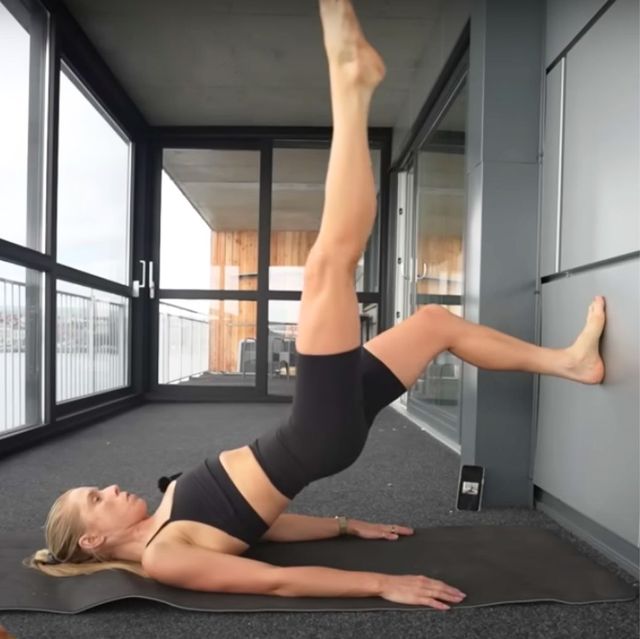
- Wall Pilates enhances core engagement by using the wall for support, leading to improved strength and stability.
- It promotes flexibility through guided stretching against the wall, improving the overall range of motion and joint flexibility.
- Wall Pilates emphasizes mindfulness and controlled breathing, enhancing mental clarity and reducing stress levels.
Pilates, known for its core-strengthening and flexibility-enhancing benefits, has seen many adaptations over the years. One of the latest trends is Wall Pilates, which utilizes a wall as a prop to assist in various exercises. This method not only adds a new dimension to traditional Pilates routines but also promises enhanced benefits.
The Science Behind Wall Pilates
Wall Pilates uses the wall to offer stability and resistance while incorporating the essential elements of classical Pilates, such as regulated movements, breathwork, and core activation. The wall is a useful tool for deepening stretches, maintaining appropriate alignment, and raising the challenge level of specific exercises. Wall Pilates can target muscles more efficiently and improve balance and coordination by including this vertical aspect.
Studies show that resistance and stability exercises like those in Wall Pilates can increase muscle activation and boost functional strength. Exercises can be safer and easier for beginners to perform while still offering difficulties for more experienced practitioners because the wall serves as a physical barrier and support.
Benefits of Wall Pilates
Wall Pilates offers a range of benefits that extend beyond those of traditional Pilates:
- Improved Flexibility and Strength: The wall helps in deepening stretches and ensuring proper alignment, which can enhance muscle flexibility and strength over time.
- Enhanced Posture and Balance: Using the wall for support allows for better posture alignment and stability, which is crucial for balance.
- Injury Prevention and Rehabilitation: The stability provided by the wall makes it a safer option for those recovering from injuries or with limited mobility.
- Stress Relief and Mental Health: Like traditional Pilates, Wall Pilates emphasizes mindful movement and breath control, which can help reduce stress and improve mental well-being.
Wall Pilates vs. Traditional Pilates
While Wall Pilates and traditional Pilates share many similarities, there are key differences:
- Use of the Wall: The most obvious difference is the incorporation of the wall, which adds an element of resistance and support not found in Mat or Reformer Pilates.
- Accessibility: Wall Pilates can be more accessible to beginners or those with physical limitations due to the added stability.
- Exercise Variety: The wall allows for a greater variety of exercises, including vertical movements that aren’t possible with traditional Pilates equipment.
- Intensity Levels: Depending on the exercise, Wall Pilates can either increase or decrease the intensity of a workout compared to traditional methods.
Who Can Benefit from Wall Pilates?
Wall Pilates is versatile and can be beneficial for a wide range of individuals:
- Beginners: Those new to Pilates can use the wall for support, making it easier to learn proper form and technique.
- Advanced Practitioners: Experienced individuals can use the wall to add complexity and resistance to their workouts.
- Older Adults: The wall provides stability, making it a safer option for older adults who may have balance issues.
- Individuals with Injuries: Those recovering from injuries can benefit from the low-impact nature of Wall Pilates and the added support the wall provides.
Common Wall Pilates Exercises
Here are some popular Wall Pilates exercises that you can try:
- Wall Roll Down: This exercise helps in spinal articulation and stretches the back muscles. Stand with your back against the wall, feet hip-width apart, and slowly roll down vertebrae by vertebrae.
- Wall Squats: With your back against the wall, slide down into a squat position. This exercise strengthens the quadriceps and glutes.
- Leg Lifts: Using the wall for support, lift one leg at a time, which helps in improving balance and strengthening the hip flexors.
- Wall Plank: Place your hands on the wall and walk your feet back to create a plank position. This variation reduces the intensity compared to a floor plank but still engages the core effectively.
Potential Drawbacks and Considerations
While Wall Pilates has many benefits, there are some considerations to keep in mind:
- Limited Range of Motion: Some exercises may have a limited range of motion due to the wall, potentially reducing their effectiveness.
- Space Requirement: Not everyone has access to a suitable wall space at home, which can limit the ability to practice Wall Pilates.
- Instructor Guidance: Proper form is crucial to avoid injury. Beginners should ideally start with guidance from a qualified instructor.
Conclusion
In conclusion, Wall Pilates uses the resistance and support of a wall to improve core engagement, flexibility, and general strength. It is a unique take on classic Pilates exercises. The efficacy of Wall Pilates in enhancing posture, balance, and body awareness is supported by science, which makes it a flexible choice for exercise enthusiasts of all skill levels. Begin your Wall Pilates journey right now to see for yourself the advantages it may provide for your health and well-being.

Speak Your Mind